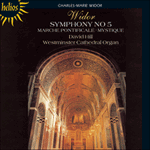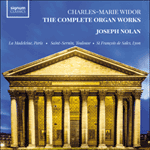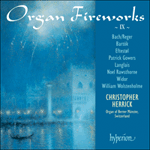
Welcome to Hyperion Records, an independent British classical label devoted to presenting high-quality recordings of music of all styles and from all periods from the twelfth century to the twenty-first.
Hyperion offers both CDs, and downloads in a number of formats. The site is also available in several languages.
Please use the dropdown buttons to set your preferred options, or use the checkbox to accept the defaults.

| David Hill (organ)» More |

'By the grace of its abundant inspiration […] the preferred symphony with the public' (Le Ménestrel, 1889), the epic Fifth similarly divides into five parts, with a reflective, suggestively terpsichorean inner core, comprising an impeccably gauged Allegro cantabile, a fantastical, whimsical A flat Andantino quasi Allegretto, and a C major Adagio. Contrasting the Sixth, however, variation procedure replaces sonata discipline. Self-evidently so in the opening Allegro vivace—a bronzed, lithe theme leading the way. And indirectly in the falling/rising step sequences of the closing maggiore Toccata—a fabled 'wedding' allegro of simple yet ingenious tonal patterning, thunderous climax, inexorable foot-work, and unremitting manual dexterity, the octuplet semiquavers of the right-hand calling for high-velocity staccato articulation. The first ascertainable public performance was given by Widor in Lyon on 16 December 1880, inaugurating Cavaillé-Coll's new organ in Saint François de Sales. From this fact, a handful of truncated Paris outings in 1879—at Saint François Xavier (27 February, first movement) and the Trocadéro—and the internal evidence of the score, Near reasons interestingly that the Fifth may have been composed 'with an instrument other than Saint-Sulpice in mind'—just as the Sixth had been intended for elsewhere (the 1878 Exposition Universelle). 'Several passages require an expressive Positif division—something that the Saint-Sulpice organ did not have, but which Saint François Xavier [built by Fermis & Persil], Saint François de Sales and the Trocadéro instruments included.'
from notes by Ateş Orga © 2019
 Widor: Symphony No 5 Widor: Symphony No 5‘Very thrilling. An irresistible sound’ (BBC Record Review)» More |
 Widor: The Complete Organ Works Widor: The Complete Organ WorksRecorded on the Cavaillé-Coll organs (Symphonies 1-9 at La Madeleine, the other works in Toulouse and Lyon) so beloved of Widor, Joseph Nolan's mammoth survey represents an ideal marriage of composer, instrument and performer: 'Nolan’s combination ...» More |
 Organ Fireworks, Vol. 9 Organ Fireworks, Vol. 9‘Another feast of organ music played on a fine instrument. Herrick’s playing … can only be described as unfailingly brilliant … Hyperion has ... ‘A definite recommendation for this latest Fireworks CD is in order’ (International Record Review)» More |

